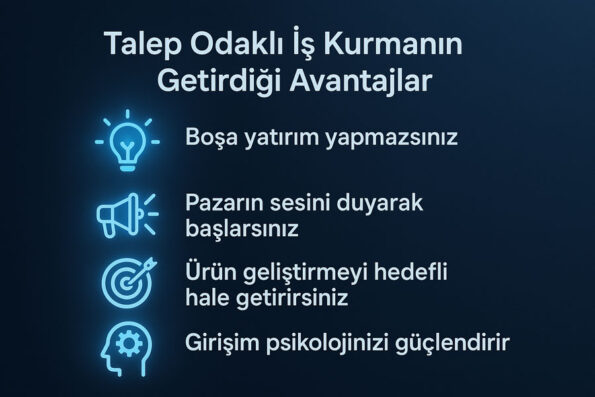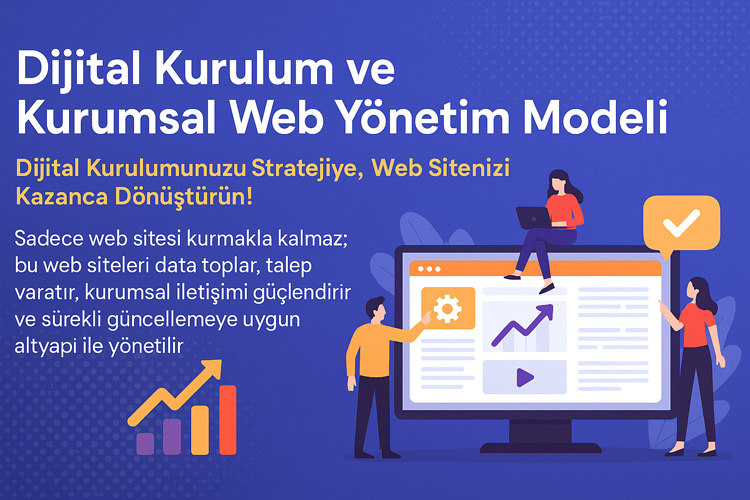İçindekiler
ToggleStart with Demand, Not Prediction
Can a Product Be Developed Before a Customer Comes? Yes, It’s Possible with Digital. Starting a business and collecting demand is a big decision, but starting with the wrong product is a bigger risk. The most common mistake entrepreneurs make is thinking product-oriented. However, those who are successful in the market are those who first think demand-oriented.
In today’s digital world, it is possible to test the market, understand demands, and determine a customer profile before launching a product. The way to do this is through digital demand collection methods.
So now the question of “if I make it, will it sell?” Instead of asking the question “what will they buy if I sell them?”, we can find an answer to the question with digital data.
What is Digital Demand Collection?
It is a digital analysis and data collection process that helps understand whether the customer really wants something before starting a business.

H3: Why Should Demand Collection Be the First Step in Starting a Business?
When you come up with a new business idea, the first question that comes to mind is usually “where should we start?” In the traditional entrepreneurship approach, this question is answered as “establish a company, produce a product, advertise.” But that’s not how things work in digital. Because:
“Producing without customers is like opening a random shop on the street.”
With demand collection, you test your product, service or business model. This way, you don’t invest in vain, don’t waste time, and draw your roadmap with real data.
What Does Digital Demand Collection Really Provide?
Digital demand collection is not only an idea validation, but also the first step for product development, content strategy and target audience determination.
This process size:
- Who will want your product and why
- How much it can be sold for and with what method
- Shows which audience can be reached and how.
You do your own market research quickly, economically and measurably.
Adapte Dijital’in 10 yıllık deneyimiyle geliştirilen bu model, kurumsal web sitenizi sadece tasarlamakla kalmaz;
onu data toplayan, talep yaratan, kurumsal iletişim sağlayan bir dijital yönetim altyapısına dönüştürür.
Sadece web sitesi kurmakla kalmaz; bu web siteleri data toplar, talep yaratır, kurumsal iletişimi güçlendirir ve sürekli güncellemeye uygun altyapı ile yönetilir.
What Data Is Used in the Demand Collection Process?
In the digital world, almost every click, every form fill is a piece of data. The following digital data are the most critical indicators when collecting leads:
- Landing page visits
- CTA clicks and conversion rates
- Survey responses and form fill rates
- Ad cost per click and engagement time
- SEO performance data (Google Search Console)
With this data, you can guess without:
“Will this product sell?” instead you can say “They already started asking for it.”
How to Combine Demand Gathering with MVP Testing
The concept of the Minimum Viable Product (MVP) further strengthens the process when combined with demand gathering. For example;
- You can offer the basic version of the product without producing the full version yet.
- You collect pre-orders or registrations with the concept of “coming soon”.
- You get feedback from those who purchased the first experience or filled out the form.
This will help you understand how your product will be received in the market. It allows you to see before you start a business.
What are the Digital Methods of Collecting Leads?
Collecting leads isn’t just about sending surveys. Today’s digital tools offer a variety of creative and strategic methods. The important thing here is to choose the right channels and set up an efficient testing system.
Pre-testing with Landing Pages
One of the first steps of setting up a digital business is a properly designed landing page. By promoting your product or service on this page:
- Attracting users’ attention
- Offering them an offer (pre-registration, notification, download, etc.)
- Measure engagement levels.
This is one of the most effective ways to generate demand even with a product that is “not yet on sale.”
Idea Testing with Google and Social Media Ads
Idea tests can be done with small budgets with Google Ads and social media ads (Instagram, Facebook, LinkedIn). For example;
Adapte Dijital’in 10 yıllık deneyimiyle geliştirdiği modellerle, kurumsal web sitenizi kurumunuzu/markanızı anlatan, tanıtan, güven yaratan, talep oluşturan bir dijital yönetim platformuna dönüştürür.
Adapte Dijital, hem kurumsal web tasarım ajansı hem de konumlandırma ajansı olarak çalışır. Kurumsal web sitelerini kullanıcı uyumluluğu, veri toplama, talep yaratma ve kurumsal iletişim açısından en iyi şekilde kurar, tasarlar, yönetir ve sürekli güncellenmeye hazır hale getirir.
- 3 different titles are tested with a budget of 500 TL
- Which title is clicked more?
- Which target audience is interested in?
This data shapes both your product and content strategy.
Organic Demand Observation with Content Creation
Organic demand can also be tested through blog posts, social media content and video sharing. For example;
- “What do people who use this product think?” comments on the article
- Most watched video titles
- Topics of most read content
These quietly tell you what your customer needs.
Data Collection with Surveys, Forms and CRM Integration
Demand data can be collected via on-site forms, pop-up surveys or directly via CRM systems.
Sample applications:
- “Tell us what you need” form
- “Leave an email to be the first to know about new product launches” field
- “We want to get to know you better” surveys
These forms don’t just collect information, they also create your potential customer database.
Developing Products and Strategy with Collected Data
Every piece of data you collect digitally is actually a roadmap for your strategy. The behavior of users who click on ads, page interactions, filled forms, and feedback received show you what your product should be. This information shapes not only your product, but also your content plan, target audience, and even your pricing. You can see which feature of your product draws more attention, at what point users exit the site, or which message gets more clicks. This way, you don’t build your business blindly, but through a constantly evolving learning process. This also gives confidence to your team, investors or potential partners, because now you have a strategy proven by data, not just an idea. Demand collection is not just market validation, it is the foundation of a growth model.
Which product do they want the most?
Your product range may be wide, but that doesn’t mean you have to produce them all at the same time. You can see which product or service stands out by analyzing which product pages visitors spend more time on. Keywords that drive conversion in advertising campaigns also give you strong signals in this regard. This analysis makes your production and stock decisions more rational. Instead of costly experiments, it allows you to prioritize based on data. As a result, you will proceed with the product that is not only liked but also in demand. This helps you use your resources more efficiently. This approach minimizes losses, especially when starting a new business.
Which price range provides conversion?
Price strategy is one of the most sensitive issues in the business. Being too cheap can reduce brand value, while high prices can prevent sales. In the digital environment, it is possible to measure conversion rates thanks to A/B tests conducted with different price options. For example, you can create landing pages with different prices for the same product and see which page attracts more sales or demand. In addition, form abandonment rates can help you understand that users are “interested but find it expensive.” Instead of lowering the price with this data, you can also increase the perception of value. In short, the price should be determined by the data, not the market. This is one of the most valuable advantages of digital.
What content do users respond to?
Demand is not only for products, but also for content. If a page of yours is viewed by a thousand people but receives zero forms, there is a problem. Maybe your title is not interesting, or maybe the message is not clear. You can develop your content strategy with data such as which content users spend time on, which blogs they share, and which pages they exit immediately. The performance of the words, images, and CTAs used especially on landing pages directly affects your conversion rate. When you give the visitor the right message at the right time, demand comes naturally. That’s why content should not only be beautifully written, but also focused on conversion. Understanding the user is turning words into strategy.
Which channel is more valuable?
Drawing traffic to your site is important, but drawing the right traffic is more important. Comparing the behavior of users coming from channels such as Google, social media, email or referrals will clarify your channel strategy. For example, if users coming from Google Ads exit immediately, ad targeting may be wrong. If those coming from Instagram visit more pages and fill out forms, it would be wise to shift your investment there. Each channel has its own dynamics and not all of them are equally valuable. Being able to make this distinction makes not only the budget but also the strategy efficient. Because in digital, the issue is not reaching many people, but reaching the right people.
Advantages of Establishing a Demand-Driven Business
Entrepreneurs usually make “guesses” when establishing a business. Sometimes these predictions come true, sometimes they end in disaster. However, thinking demand-oriented allows you to establish your business not only with “faith” but also with evidence.
A business idea, no matter how brilliant, is not sustainable if it does not have a market response. Therefore, the first step in establishing a business is to ask the question “Is there demand?”. When the answer to this question is based on data, both investors, team members and you will be on much safer ground.
You won’t make a wasted investment
The demand collection process protects you from wrong investments by testing your product or service. The data obtained before stocking, starting production, or even establishing a company will guide you to take more rational steps. This approach is especially vital for entrepreneurs who operate with limited budgets. While it is necessary to measure the customer density in the region even before opening a physical store, you can do this measurement much more easily in digital. In this way, you do not direct your resources to the wrong channel or the wrong product, but invest in real interest. This significantly reduces the costs when starting a business. In short, if there is demand, there is investment.
You start by hearing the voice of the market
The demand collection process is the beginning of communication with the customer. At this stage, you learn what users need, expect and pay attention to. In light of this information, you can reshape your product, service or content. Every strategy developed without knowing the customer is based on coincidence. However, every step shaped together with the customer establishes a stronger bond. Demand collection creates not only data, but also an emotional ground. Because people are more connected when they feel that the things they are interested in are heard. This forms the basis of long-term customer loyalty.
You make product development targeted
In the traditional approach, product development is based on the logic of “produce first, then test”. But in this process, resources are consumed, time is lost, and there is often no return. However, in a business that starts by collecting demand, product development is more targeted, more flexible, and faster. Which features are important and what is unnecessary are determined by data. Thus, a simple but effective product emerges. This is exactly where the MVP logic comes into play: Start small first, then improve with feedback. This cycle ensures that the product is not only sellable, but also lovable. Because development comes from the customer.
Entrepreneurship strengthens your psychology
An entrepreneur who moves forward with data experiences less stress. He knows what and why he invests. He can measure every step, and sees success or failure as structural, not personal. This keeps motivation high. Uncertainties can be exhausting, especially for early-stage entrepreneurs. But if you have concrete demand data, your field of action is clearer. When data speaks, doubts are silenced. This reduces the psychological burden of the business establishment process. Strong motivation means better decisions and a more sustainable initiative.

Integrated Process of Demand Collection with Adaptive Business Model
Digital demand collection is not a campaign, it is a process. Adaptive Business Model integrates this process into the basic structure of the business. In other words, it is not just about setting up a website; it is about transforming the site into a research, measurement and development system. Every visitor is an idea, every form is a demand, every click is a feedback. In this model, the website, CRM, content production and advertisements work as a whole. Thus, the entrepreneur gains not only sales but also forecast. Products, content and campaigns are directed according to the customer’s interest. Business is no longer based on guesswork, but on learning.
Website: The Digital Center of Demand Collection
The website is the starting point of digital entrepreneurship and the center of demand collection. A site with the right structure does not only inform visitors, it analyzes their behavior and reveals where they show interest. Content, CTA buttons and conversion-focused forms should be strategically placed to collect demand through the website. In addition, the performance of landing pages should be analyzed regularly. Each page of the site should be seen as a testing ground; continuous improvement should be made in light of feedback. This makes the website an active sales and research tool, not a passive one.
Sample applications:
- Demand-driven “apply now” or “be the first to know” CTAs
- “Interested?” under targeted product pages forms
- Post-visit feedback surveys
- Pop-up offers for abandoners
- Integration of behavioral analysis tools like scroll-heatmap
Google Ads Demand Test Integration
In the Adaptive Business Model, ads are not just a promotional tool, but a data collection engine. Collecting demand with Google Ads means directly observing which problems your target audience is looking for solutions to. By testing different headlines, offers and targeting with small-budget campaigns, many metrics from ad clicks to behaviors can be analyzed. Which ad visitors stay on the site longer? Which headline drives conversion? With this data, it becomes clear which aspect of your product should be highlighted, and how it should appeal to which audience. Advertising is used not only to reach, but also to understand.
Sample applications:
- A/B test with ad sets created with 3 different titles
- Real demand measurement with ads with “Pre-order” call
- Detection of interest through attractive but unsold products
- Targeting based age/gender/education analysis
- CRM matches of those who filled out the form after the campaign
Categorizing Demand Collected with CRM
Categorizing and evaluating the collected data is as important as collecting demand. Within the Adaptive Business Model, CRM systems carry not only sales opportunities but also analysis points that determine the direction of the business. Every form, every e-mail, every offer request left by visitors is grouped into certain segments. Thus, details such as the most demanded product, price range, target demographics are revealed. In addition, follow-ups made on the CRM measure product-market fit by showing which process visitors have gone through over time. In this way, the initiative does not only collect data; uses this data systematically.
Sample applications:
- Automatic tagging of form data with CRM integration
- Creating categories according to fields such as “product type / price / purpose of use”
- Segmentation ranked according to potential customers
- Separate pooling of recurring requests
- Enrich with notes after customer meetings
Continuous Improvement: Data-Driven Updates
Collecting requests It is not a one-time action; it is an ongoing, transforming and evolving process. Therefore, the Adaptive Business Model analyzes demand data weekly or monthly and makes changes to content, product or pricing according to the results obtained. For example, a new product development decision can be made according to the most read blog topics. Or a rewritten title can be tried on the most abandoned page. This cycle keeps the business alive. Because the market changes, user expectations change, competitors change. Not only the product, but also the strategy should be adaptive. A constantly evolving data management culture transforms your business into a learning organism.
Sample applications:
- Review of monthly page performance reports
- Comparing Heatmap with user behavior
- Shaping new content and titles based on user feedback
- Re-adjusting pricing strategies based on demand
- Renewing ad texts based on conversion rates
Closing: If the Customer is Ready, the Product is Born
In today’s world, starting a business starts with understanding a need before producing a product. When that need is clear, when demand starts to gather, when feedback takes shape, the product emerges on its own. That’s exactly why the Adaptive Business Model says “listen first, then produce”. Offering something to a customer before they even ask for it is now a huge risk. However, hearing what the customer wants and understanding their needs with digital data allows you to make a strong start before you even start.
With the digital demand collection process, you:
- You act with data, not guesswork.
- You don’t invest in vain, you use your resources wisely.
- You get to know your customer before your product even comes out.
- You manage product-market fit with a live process.
- You start growing your startup before it’s even established.
In short:
“If the customer is ready, the product is born. If the market is open, the idea grows. If there is data, the risk “
👉 If you want to set up your digital demand collection system and start your business based on data, contact us.






